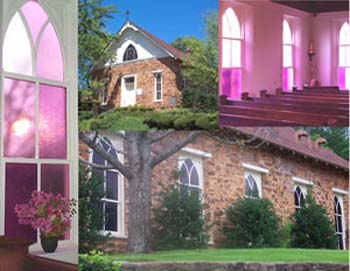


800 First Avenue
Opelika, Alabama
P.O. Box 2332
Opelika, AL 36803
(334) 745-2054
emmanuelepiscopal.
faithweb.com

Emmanuel
Episcopal Church is a pioneer work of art, a church built of native fieldstone
dug from Southern farmland in the 19th century by a small group of Episcopalians
determined to create a church for themselves on the Alabama frontier.
The oldest public building in Lee County, Emmanuel is a landmark to the
railroad town of Opelika.
Emmanuel was admitted into the Alabama Diocese in 1860. The first church, a frame building consecrated in 1862 "in these Confederate States of America," was destroyed by a tornado seven years later. The parishioners saved the rubble and built a rectory from the remains where they worshipped until it was destroyed by fire in 1874. From there the church moved to a nearby school to conduct services until moving into the church which stands today. The cornerstone for the "new" stone church was laid on Easter Day 1872, and the building was first used for services in 1876. It was no small accomplishment building a church in the deep South during Reconstruction. Newspaper accounts reveal that by 1888 the parishioners worshiped within today's stone walls, but they did so with the building unplastered, with no altar platform or altar equipment, no narthex, no vestry room, no benches and with only temporary fillings for windows; they used a screen for the priest, common chairs for the people, and knelt on a cushioned board on the level floor around a covered store-box for an altar(!).
Emmanuel is not graced by a single ornate architectural feature. Its beauty rests in the simplicity and quiet charm of a country church. Nestled in azaleas and dogwoods, the structure is as rural and close to the earth as the community in which it stands. Parishioners today sit on the same 18 benches that existed in 1899 with the heart of pine single-board backs and simple cross carvings on the sides of the benches at the base. The nave, paneled with walnut, exhibits a simple Victorian town church Gothic design. Incredibly simple lavender windows provide an openness and connection to the outdoors. The best example of Emmanuel's down-to-earth style is how it is adorned at Easter. Besides Easter Lilies, fresh flowers of azaleas, daffodills and dogwood are cut and placed in containers to sit on the windowsills around the nave.
Parishioners treasure the little stone church, and, during times of adversity,
remind each other that as a church we survived the Civil War and Reconstruction;
surely we will survive whatever we face today.